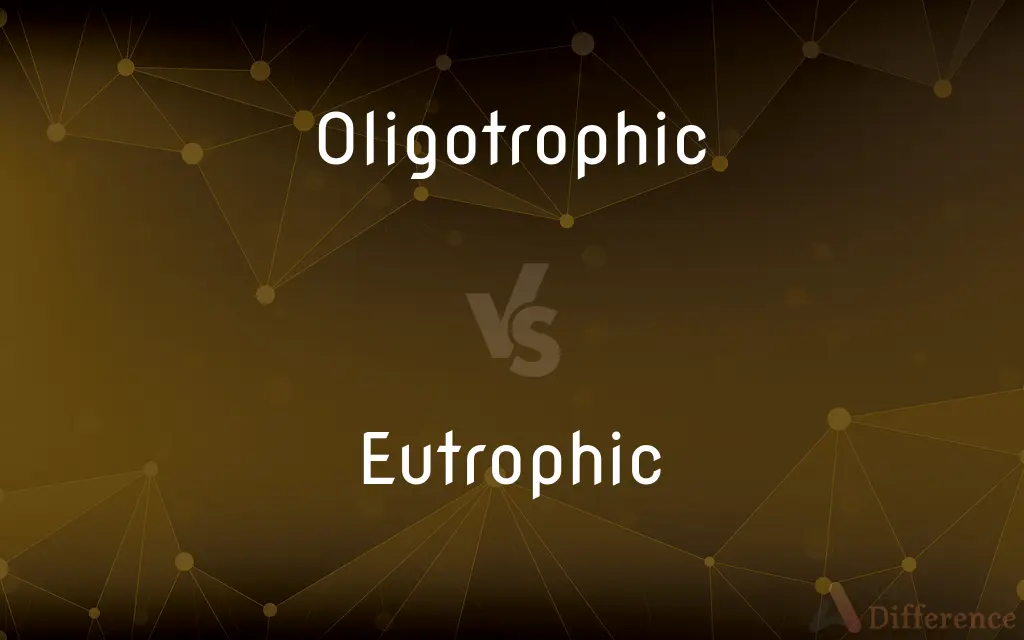Oligotrophic vs. Eutrophic — What's the Difference?
By Maham Liaqat & Urooj Arif — Updated on April 18, 2024
Oligotrophic waters are nutrient-poor and support limited aquatic life, characterized by clear waters, whereas eutrophic waters are nutrient-rich, supporting abundant life but often experiencing algal blooms.

Difference Between Oligotrophic and Eutrophic
Table of Contents
ADVERTISEMENT
Key Differences
Oligotrophic lakes and water bodies are characterized by low nutrient concentrations, particularly nitrogen and phosphorus, which limits their biological productivity. On the other hand, eutrophic waters contain high levels of these nutrients, leading to greater productivity and often resulting in dense plant and algal growth.
The water in oligotrophic lakes is usually clear, with a high dissolved oxygen content that supports a specific range of aquatic life adapted to low nutrient availability. Whereas, eutrophic waters often have murky water due to high algal concentrations, which can decrease oxygen levels, especially at deeper layers, affecting fish and other aquatic organisms.
Oligotrophic conditions are typically found in newly formed lakes or those in remote, undeveloped areas where nutrient runoff is minimal. On the other hand, eutrophic conditions are often observed in water bodies near agricultural or urban areas where runoff from fertilizers and waste contributes to high nutrient levels.
The biological communities in oligotrophic waters are less diverse due to the scarcity of food resources. In contrast, eutrophic waters can support a wide variety of plants, algae, and fish, but this diversity can be threatened by oxygen depletion and toxic algal blooms.
Eutrophication, the process of becoming nutrient-rich, can be a natural aging process for lakes but is often accelerated by human activities. Conversely, oligotrophic states are generally more stable and less likely to change rapidly unless affected by significant environmental intervention.
ADVERTISEMENT
Comparison Chart
Nutrient Level
Low
High
Water Clarity
Clear
Murky
Biological Productivity
Low
High
Typical Location
Newly formed, remote lakes
Lakes near urban or agricultural areas
Common Problems
Limited biodiversity
Oxygen depletion, algal blooms
Compare with Definitions
Oligotrophic
Low in nutrients.
The oligotrophic lake had crystal clear waters.
Eutrophic
High in nutrients.
The eutrophic lake supports a wide variety of aquatic plants.
Oligotrophic
Supporting limited life.
Few fish species thrive in oligotrophic conditions.
Eutrophic
Affected by runoff.
Runoff from nearby fields has eutrophied the lake.
Oligotrophic
Stable environment.
The oligotrophic state of the lake has remained consistent for decades.
Eutrophic
Low oxygen in deep layers.
The bottom waters of the eutrophic lake are often oxygen-depleted.
Oligotrophic
Found in remote areas.
The remote mountain lake is oligotrophic.
Eutrophic
Rapid environmental change.
The lake became eutrophic over just a few years due to increased nutrient runoff.
Oligotrophic
High oxygen levels.
Oligotrophic waters are often oxygen-rich, supporting unique ecosystems.
Eutrophic
Prone to algal blooms.
Summer algal blooms are common in eutrophic waters.
Oligotrophic
Lacking in plant nutrients and having a large amount of dissolved oxygen throughout. Used of a pond or lake.
Eutrophic
Rich in mineral and organic nutrients that promote a proliferation of algae and aquatic plants, resulting in a reduction of dissolved oxygen. Used of a lake or pond.
Oligotrophic
Deficient in nutrition (providing little nourishment)
Eutrophic
Being rich in nutrients and minerals and therefore having an excessive growth of algae and thus a diminished oxygen content to the detriment of other organisms.
Oligotrophic
Being poor in nutrients and minerals and therefore not having an excessive growth of algae and thus a no diminished oxygen content to other organisms.
Eutrophic
(medicine) Promoting nutrition.
Oligotrophic
Deficient in plant nutrients, such as nitrogen or phosphorus.
Eutrophic
(medicine) A eutrophic medicine.
Common Curiosities
Why is biodiversity lower in oligotrophic lakes?
The low nutrient availability limits the growth of plants and algae, which are the base of the food web.
How do human activities influence eutrophication?
Activities like agriculture, urban runoff, and improper waste disposal increase nutrient levels, accelerating eutrophication.
What kind of fish are found in oligotrophic lakes?
Species adapted to low nutrient environments, often cold-water species like trout.
How does eutrophication affect water quality?
It typically leads to poorer water quality, with potential health risks from toxic algae and decreased oxygen levels.
What preventive measures can limit eutrophication?
Reducing fertilizer use, proper wastewater treatment, and riparian buffers can help prevent nutrient runoff.
What are the consequences of eutrophication?
Increased nutrient levels can lead to excessive algal growth, oxygen depletion, and loss of fish species.
What are the signs of a eutrophic lake?
Common signs include murky water, frequent algal blooms, and visible sedimentation.
Can eutrophic waters be restored to oligotrophic?
Restoration is challenging and involves reducing nutrient inputs and sometimes active management strategies.
What causes a lake to be oligotrophic?
Low nutrient levels, often due to location in undeveloped or remote areas, lead to oligotrophic conditions.
Is oligotrophy always preferable to eutrophy?
While oligotrophy often seen as more desirable.
Share Your Discovery

Previous Comparison
Bullet vs. Cap
Next Comparison
Eigenvector vs. EigenstateAuthor Spotlight
Written by
Maham LiaqatCo-written by
Urooj ArifUrooj is a skilled content writer at Ask Difference, known for her exceptional ability to simplify complex topics into engaging and informative content. With a passion for research and a flair for clear, concise writing, she consistently delivers articles that resonate with our diverse audience.














































